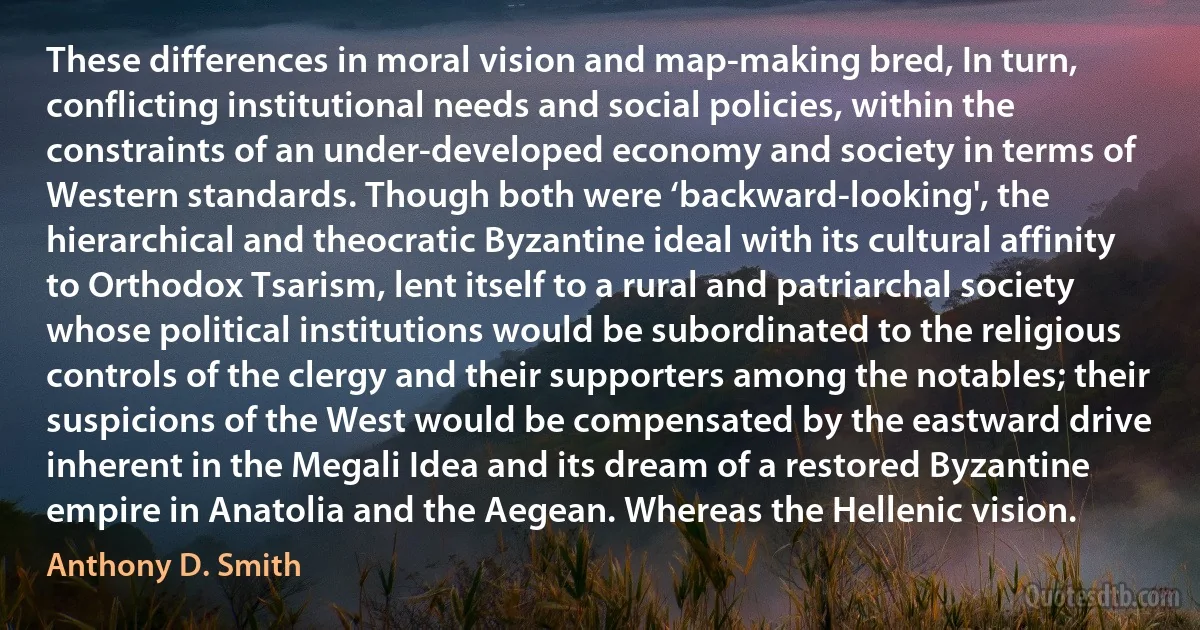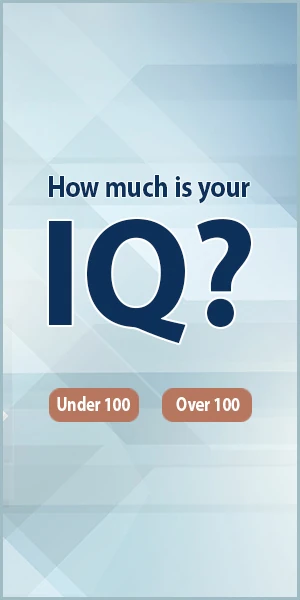
These differences in moral vision and map-making bred, In turn, conflicting institutional needs and social policies, within the constraints of an under-developed economy and society in terms of Western standards. Though both were ‘backward-looking', the hierarchical and theocratic Byzantine ideal with its cultural affinity to Orthodox Tsarism, lent itself to a rural and patriarchal society whose political institutions would be subordinated to the religious controls of the clergy and their supporters among the notables; their suspicions of the West would be compensated by the eastward drive inherent in the Megali Idea and its dream of a restored Byzantine empire in Anatolia and the Aegean. Whereas the Hellenic vision.
Anthony D. SmithRelated topics
aegean breed byzantine dream drive eastward hellenic idea lent needs orthodox rural turn vision west westernRelated quotes
One theory is that the antichrist will be a major political leader in the United Nations and the "many” referred to is the UN. Another theory is that the "many” refers to the Arab League of Nations since their mosques are now on the temple mount where the temple needs to go. Many believe there is room to put the temple on a ten-acre plot north of the two mosques. The temple mount is about 37 acres. Keep an eye out for a treaty that allows Israel to rebuild the temple! If one is made, start the clock ticking again for that final week! It may be the Muslims will offer to trade the Jews ten acres on the temple mount to build their temple, for the entire West Bank? Plus five gazillion dollars! Israel wants that spot bad enough to pay any price. We'll see.

Kent Hovind
I decided (after listening to a "talk radio" commentator who abused, vilified, and scorned every noble cause to which I had devoted my entire life) that I was both a humanist and a liberal, each of the most dangerous and vilified type. I am a humanist because I think humanity can, with constant moral guidance, create a reasonably decent society. I am terrified of restrictive religious doctrine, having learned from history that when men who adhere to any form of it are in control, common men like me are in peril. I do not believe that pure reason can solve the perpetual problems unless it is modified by poetry and art and social vision. So I am a humanist. And if you want to charge me with being the most virulent kind-a secular humanist-I accept the accusation.

James A. Michener
No greater mistake can be made than to think that our institutions are fixed or may not be changed for the worse. ... Increasing prosperity tends to breed indifference and to corrupt moral soundness. Glaring inequalities in condition create discontent and strain the democratic relation. The vicious are the willing, and the ignorant are unconscious instruments of political artifice. Selfishness and demagoguery take advantage of liberty. The selfish hand constantly seeks to control government, and every increase of governmental power, even to meet just needs, furnishes opportunity for abuse and stimulates the effort to bend it to improper uses... The peril of this Nation is not in any foreign foe! We, the people, are its power, its peril, and its hope!

Charles Evans Hughes
Among the features peculiar to the political system of the United States is the perfect equality of rights which it secures to every religious sect. And it is particularly pleasing to observe in the good citizenship of such as have been most distrusted and oppressed elsewhere, a happy illustration of the safety and success of this experiment of a just and benignant policy. Equal laws protecting equal rights, are found as they ought to be presumed, the best guarantee of loyalty, and love of country; as well as best calculated to cherish that mutual respect and good will among citizens of every religious denomination which are necessary to social harmony and most favorable to the advancement of truth.

James Madison
Mark Twain said that faith is believing what you know ain't so. Well, political correctness is doing what you know ain't right. In every western country, Islamic extremists are allowed to exploit religious privilege for political ends by claiming to represent all Muslims, and the media always treat them as if they do. These groups give themselves official-sounding titles and talk a smooth line in community harmony, while doing all they can to prevent integration: to keep Muslims apart and ghettoised in a separate society, with a separate identity, separate rules and standards. In other words, they exist to cause division in society; to drive a wedge between communities that doesn't need to be there, any more than they need to exist as organisations.

Pat Condell
